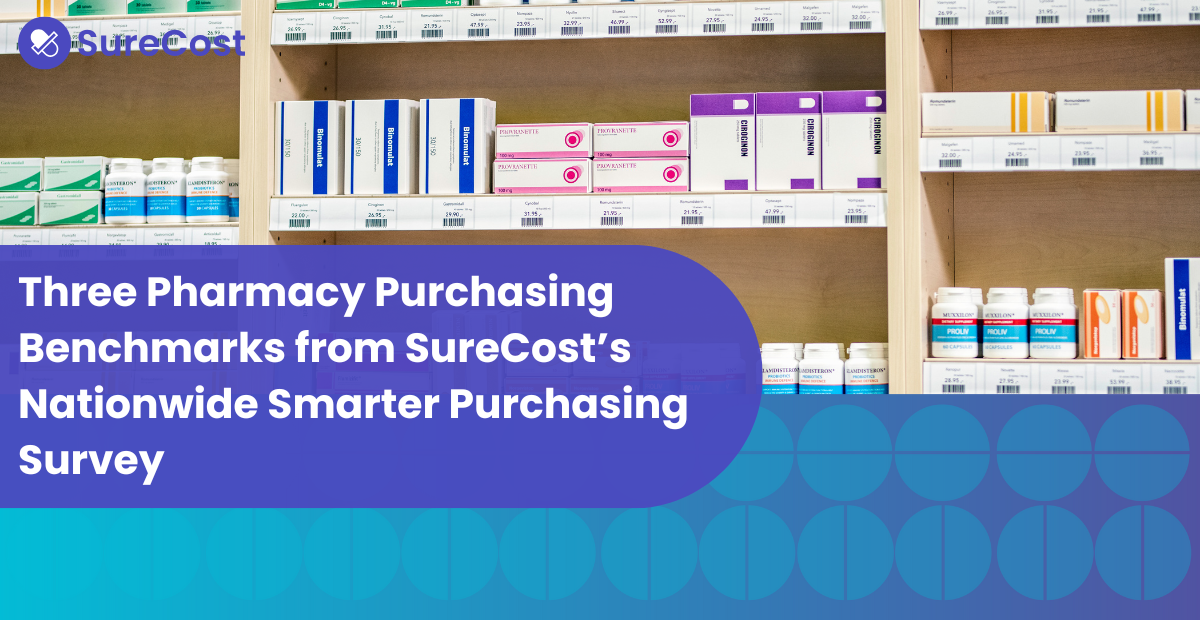Each year, SureCost conducts extensive customer analysis. Based on data from approximately 2,200 retail, long-term care and specialty pharmacies across the country, these studies share valuable insights into how pharmacies thrive in an increasingly complex industry. Respondents also relate how smarter purchasing empowers them to overcome these issues.
This blog post will summarize some key findings. For the full story of how pharmacies like yours drive savings and enhance their operations while ensuring compliance, download The 2023 Smarter Purchasing Report.
Save More By Purchasing Beyond the Top 200
Unfortunately, pharmacy professionals know the “opaque” nature of the pharmacy purchasing ecosystem too well. It was never designed for transparency.
Pharmacy purchasing means navigating a web of brand names, generic alternatives, product categories, wholesalers, secondary vendors, catalogs and purchasing interfaces. “The best price” is neither easy to find nor calculate. The lowest-priced item onscreen could yield the highest cost of goods sold (COGS) if it doesn’t meet compliance targets. And that high-price product might have been your cheapest option after reimbursement. Most pharmacies don’t have the time to pore through all the information and crunch all the numbers.
Unsurprisingly, pharmacies count on generic medications as their most affordable choices. Yet SureCost customers have discovered significant discounts buying the right generics. By shopping outside the “Top 200” generic medications, these pharmacies report an average COGS savings of 19%. That’s more than double the savings from sticking to the Top 200. For example, a pharmacy that buys outside the Top 200 with SureCost saves about 3% annually on average—roughly $90,000 each year!
SureCost customers shop outside the Top 200 without wasting hours hunting for those better purchasing options. Instead, they use technology to gain visibility into the market. SureCost works with all major wholesalers plus the majority of secondary vendors. It allows pharmacies to search an expanded vendor catalog (beyond just relying on their primary and without manually searching secondaries). At the same time, the solution monitors for compliance. Their purchases always adhere to vendor agreements and custom rules.
In short, pharmacies use SureCost for huge savings by purchasing from a variety of vendors while ensuring compliance.
Ensure Accurate Value of Received Goods
Alongside increased savings on the products they purchase, pharmacies also leverage smarter purchasing to reduce expensive errors in the procurement process.
Everyone makes mistakes. Vendors sometimes charge pharmacies the wrong amount for goods. They might short the amount delivered but charge for the full quantity. They sometimes forget to pack an item but still include it on the invoice. “Miss-picks” (sending the wrong product but still billing the pharmacy) are another costly vendor error.
How costly? SureCost customers reported costs of 0.34% or more and a 23-basis point discrepancy between the actual quantity of goods received versus the invoiced price. For a pharmacy with an average annual expenditure of $3M, that’s about a $7K annual loss.
SureCost gives pharmacies a single interface to quickly compare purchase orders, received products and vendor invoices. By integrating purchasing and accounts payable through SureCost, as soon as you receive an item, you can check invoices against orders. The solution flags potential discrepancies and provides a virtual “paper trail” to address issues with vendors.
Regardless of your purchasing volume, how much do you want to pay for items you didn’t get or didn’t need? With SureCost, pharmacies always receive the right product at the correct quantity for the agreed-upon price.
Avoid Vendor Non-Compliance
Along with shipping errors, vendors sometimes mistakenly charge more than their quoted contract price. In most cases, it’s up to the pharmacy to spot and address these oversights. Pharmacies literally pay more than they bargained for.
This might be the most astonishing statistic from the latest Smarter Purchasing Report:
SureCost users encountered pricing issues on approximately 16% of all contracted items. This has led to a significant cost increase of over 2.5% for several pharmacies, with an average spike of 27 basis points in costs. For a retail pharmacy with an annual purchasing volume of $3M, this results in $8,100 per year being spent on invoices they shouldn’t be paying.
Even with much lower purchasing volumes, pharmacies are spending money they shouldn’t have to. And numbers can’t’ quantify the stress of wondering if your vendor made an honest but costly mistake and fretting over every purchase.
With SureCost monitoring purchases, these pharmacies are now aware of potential pricing discrepancies. They get an alert when any vendor fails to honor their pricing. Plus, the information needed to report back to the vendor is at their fingertips. By leveraging transparency into their purchasing, your pharmacy can stop losing money it never should have spent in the first place.
Eliminate Costly Reorders
Reordering is another expensive and stressful part of pharmacy purchasing: there’s a spike in demand for an item, pharmacies attempt to reorder that product, they scramble to find a vendor carrying it who can deliver in a timely manner, and end up paying more (if they even find that vendor). Along the way, you and your team have to explain to patients why your pharmacy can’t fill their prescriptions. That disrupts patients’ medical treatment and trust in their local pharmacy. They may seek other options besides your pharmacy.
In terms of the scope of reorders, pharmacies reported that 2.5% of products required reorders with a reorder cost of 10 basis points on average. Yet it’s worth noting that, for some pharmacies, reorders surged up to about 20% and 45 basis points. Every reorder means losing time and money while increasing stress on staff (while staffing shortages are already on the rise).
Between supply chain issues, regulatory challenges and complex patient profiles driving demand, reorders will always be a fact of the pharmacy business. Pharmacies will have to stay prepared for them:
- Spot potential out-of-stocks early
- Order what you need before a shortage hits
- Quickly determine compatible in-stock products
- Prevent last-minute reorders and unexpected backorders
- Avoid paying more as you scramble to replenish
SureCost inventory management integrates with purchasing so you can instantly view your actual inventory—on shelves, on its way or available at other locations—at its actual value. The system alerts you to potential supply problems according to min/max values you determine. When supply hits that preset number, the system notifies you and identifies the best purchasing options for your patients, vendor compliance and your bottom line.
Pharmacy professionals may always have to manage “on-the-fly” reorders. But you can always have the right products to respond to patient needs and reduce COGS.
Track Vendor Substitutions
As our report details, among some SureCost customers, “vendors [deliberately] substituted an astounding 7.45% of their generic purchases.” That’s just among generics in terms of dosage form, strength and package size. And those vendors did not consistently inform pharmacies of these substitutions.
Pharmacy teams have so much on their plate that they rarely notice substitutions; they assume they’re getting what they ordered every time. Instead, pharmacies surveyed ended up paying over $35,000 per year for a different item than the one they needed.
Like it flags receiving/invoice errors and failure to honor contract pricing, SureCost alerts pharmacies about vendor substitutions. You can instantly view any substituted items alongside their costs. That means spotting the issue immediately so you can quickly address it with the vendor. Some pharmacies even use SureCost to prevent any substitutions.
Regardless of how your pharmacy chooses to handle substitutions, increased awareness allows you to reduce the cost and labor associated with them. More importantly, you gain another way to ensure your patients always get the medications they need when they need them.
Conclusion
The most recent Smarter Purchasing Report outlines the full impact that smarter purchasing makes in lowering COGS, reducing costly inefficiencies and enhancing processes. The report also discusses other challenges confronting pharmacies today. Staffing shortages, third-party audits, new DSCSA regulations and DIR “clawbacks” are just some of the issues pharmacies confront right now.
There’s no shortage of obstacles to a pharmacy’s goals. Yet smarter purchasing ensures that patients continue receiving high-quality care, that staff get back time to spend with them, and that leadership gains business intelligence for better decisions.
.png?w=500)



.png)



